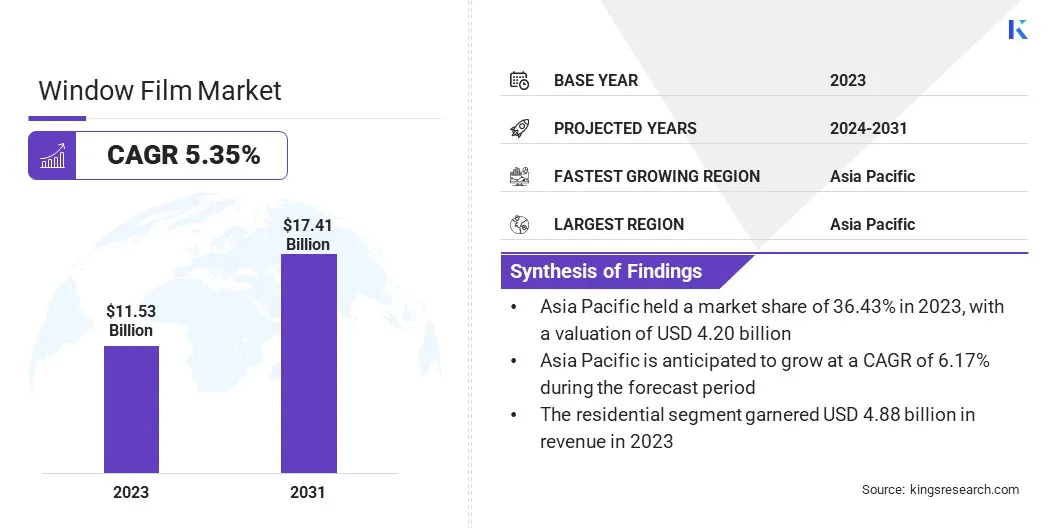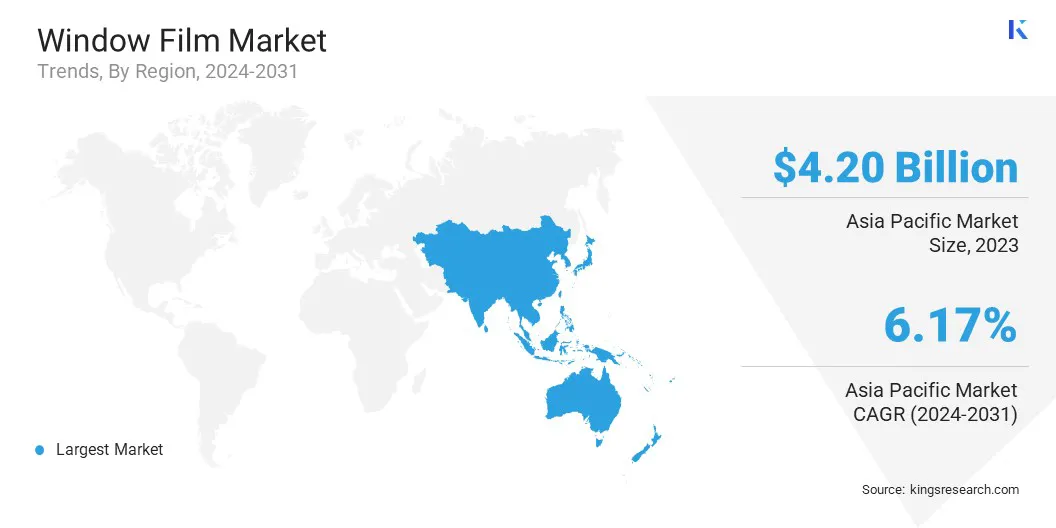Market Definition
Window films are thin, multi-layered polyester or plastic coatings applied to glass surfaces to enhance performance, durability, and aesthetics. These films serve various functions, including solar control, privacy, security, and decorative enhancement.
They help reduce heat, glare, and UV radiation, improving energy efficiency and protecting interiors from sun damage. Security window films enhance glass strength, increasing resistance to breakage, while privacy films obscure visibility without blocking natural light.
Available in tinted, reflective, frosted, or clear options, window films are widely used in residential, commercial, and automotive applications to improve comfort, safety, and appearance.
Window Film Market Overview
Global window film market size was USD 11.53 billion in 2023, which is estimated to be valued at USD 12.08 billion in 2024 and reach USD 17.41 billion by 2031, growing at a CAGR of 5.35% from 2024 to 2031.
The market is witnessing significant growth due to the increasing demand for energy-efficient solutions, as these films reduce heat gain and lower energy consumption in buildings and vehicles.
Stringent government regulations promoting sustainability are further boosting adoption across various sectors. The expanding automotive industry is creating a demand for films that offer UV protection and privacy.
Major companies operating in the window film industry are 3M, Eastman Chemical Company, Saint-Gobain Performance Plastics Corporation, American Standard Window Film, Madico, Inc., Toray Plastics, Inc., Avery Dennison Corporation, LINTEC Corporation, Hanita Coatings, Johnson Window Films, Inc., Armolan Window Films, Garware Suncontrol Film, Reflectiv Window Films, Contra Vision Limited, Waverley, and others.
The global carbon footprint is steadily increasing, raising concerns about its long-term environmental impact. In response, several countries are implementing regulatory measures and adopting sustainable practices to mitigate these effects.
- The United Nations reports that Earth’s temperature has risen by approximately 1.2°C since the late 1800s, with emissions continuing to increase. To limit global warming to 1.5°C, as per the Paris Agreement, emissions must be reduced by 45% by 2030 and achieve net zero by 2050.
Efforts to combat climate change are intesifying, with regions such as the European Union implementing decisive measures.
- In November 2024, the European Environment Agency reported a 37% reduction in EU emission in 2023 compared to 1990 levels.
As part of these global efforts, the demand for energy-efficient solutions is growing, driving the expansion of the market. These films help reduce heat gain, lowering reliance on air conditioning and cutting energy consumption across residential, commercial, and automotive sectors.

Key Highlights:
- The window film industry size was recorded at USD 11.53 billion in 2023.
- The market is projected to grow at a CAGR of 5.35% from 2024 to 2031.
- Asia Pacific held a share of 36.43% in 2023, valued at USD 4.20 billion.
- The sun control films segment garnered USD 4.92 billion in revenue in 2023.
- The residential segment is expected to reach USD 7.72 billion by 2031.
- North America is expected to grow at a CAGR of 4.98% through the forecast period.
Market Driver
"Increasing Demand for Security and Safety Films"
Rising concerns about safety and security in commercial, residential, and automotive applications are fueling the demand for window security films. These films reinforce glass surfaces, making them shatter-resistant and reducing the risk of break-ins, vandalism, and injuries caused by accidental breakage.
Businesses, financial institutions, and government buildings are investing in high-strength films to enhance protection against external threats. The increasing use of security films in high-risk areas and public transportation is bolstering market expansion.
- In March 2024, Window Film Depot (WFD), a 3M Dealer, announced its participation in the launch of the 3M ScotchShield Security Window Film S2400. Designed to enhance security measures, this advanced 3M film aims to transform window protection across multiple sectors. Its potential applications include safety glazing, blast mitigation, break-in prevention, and reducing the risk of spontaneous glass breakage.
Market Challenge
"High Initial Investment and Installation Costs"
The window film market faces a significant challenge due to the high initial investment and installation costs associated with advanced films. Premium window films with superior thermal insulation, UV protection, and security features often require specialized materials and professional installation, increasing overall expenses. This cost barrier limits adoption, particularly among small businesses and price-sensitive consumers.
To address this challenge, companies are focusing on technological advancements to develop cost-effective films without compromising performance. Additionally, businesses are offering flexible financing options, rebates, and government-backed incentives to make window films more accessible. Strategic partnerships with construction firms and automotive manufacturers are further aiding market penetration.
Market Trend
"Rising Adoption of Smart and Decorative Films"
The increasing integration of smart glass technology in commercial spaces and modern architecture is emerging as a notable trend in the window film industry, leading to surging demand for advanced solutions. Smart films allow users to control transparency levels, improving privacy and energy efficiency.
Decorative films are gaining popularity in residential and corporate environments, offering aesthetic enhancements while maintaining functionality. Businesses are investing in customizable film solutions to create visually appealing interiors without compromising natural light.
The ability to enhance both design and efficiency is positioning smart and decorative films as a key factor supporting market expansion, particularly in high-end residential and commercial applications.
- In August 2024, Avery Dennison Graphics Solutions introduced the SkyLite 20 XTRM Pro exterior skylight window film. This innovative film offers a unique solution for window film installers, architects, designers, facility managers, and building owners seeking to enhance a building’s aesthetics while improving its overall energy efficiency.
Window Film Market Report Snapshot
| Segmentation |
Details |
| By Type |
Sun Control Films, Safety & Security Films, Decorative Films, Others |
| By Application |
Residential, Commercial, Automotive, Marine |
| By Region |
North America: U.S., Canada, Mexico |
| Europe: France, U.K., Spain, Germany, Italy, Russia, Rest of Europe |
| Asia-Pacific: China, Japan, India, Australia, ASEAN, South Korea, Rest of Asia-Pacific |
| Middle East & Africa: Turkey, UAE, Saudi Arabia, South Africa, Rest of Middle East & Africa |
| South America: Brazil, Argentina, Rest of South America |
Market Segmentation:
- By Type (Sun Control Films, Safety & Security Films, Decorative Films, and Others): The sun control films segment earned USD 4.92 billion in 2023, mainly due to its ability to enhance energy efficiency by reducing heat gain, minimizing glare, and lowering cooling costs across residential, commercial, and automotive applications.
- By Application (Residential, Commercial, Automotive, and Marine): The residential segment held a share of 42.31% in 2023, furled by the increasing demand for energy-efficient solutions that reduce cooling costs, enhance indoor comfort, and provide UV protection, supported by rapid urbanization, stringent energy regulations, and growing consumer awareness of sustainable home improvement solutions.
Window Film Market Regional Analysis
Based on region, the market has been classified into North America, Europe, Asia Pacific, Middle East & Africa, and Latin America.

Asia Pacific window film market accounted for a share of around 36.43% in 2023, valued at USD 4.20 billion. Rapid urbanization and infrastructure development are boosting the adoption of window films to minimize heat gain, reduce energy consumption, and comply with strict energy-efficiency regulations in countries such as China, Japan, and India.
Moreover, the rising vehicle production and sales in Asia-Pacific, particularly in China, India, and South Korea, are fueling the demand for automotive window films that offer enhanced UV protection, improved privacy, and better interior temperature regulation.
- In 2023, according to the International Energy Agency (IEA), China recorded 8.1 million new electric car registrations, reflecting a 35% increase compared to 2022. The surge in electric vehicle sales was the primary factor boosting growth in the overall car market, offsetting an 8% decline in internal combustion engine (ICE) vehicle sales, while the total market expanded by 5%.
North America is poised to grow at a CAGR of 4.98% over the forecast period. Stringent building energy codes in the U.S. and Canada are boosting the adoption of window films to enhance thermal insulation, reduce energy consumption, and comply with sustainability initiatives such as LEED certification.
Additionally, the growing demand for UV protection, glare reduction, and interior temperature control in vehicles, coupled with regulations limiting visible light transmission (VLT) levels in automotive films, is bolstering regional market expansion.
Regulatory Framework
- The U.S. Department of Energy recommends using energy-efficient window coverings, including reflective silver or mirror-like films, to improve energy efficiency in residential buildings. These films help reduce heat gain, lower air conditioning costs, and provide comfort by minimizing glare and UV exposure.
- The National Building Code of Canada (NBC) and the Canadian Standards Association (CSA) set standards for building materials, including window films. Window films used in buildings should meet the CSA A440 standard, which pertains to the performance of building products, including windows.
- The Driver and Vehicle Standards Agency (DVSA) enforces UK regulations on vehicle window tinting. The legal limit for front and rear windshields is 75% VLT, while front side windows must have the minimum allowable light transmission of 70%. Tints darker than these limits are non-compliant with UK laws.
- In India, the Ministry of Road Transport and Highways (MoRTH) regulates vehicle window tinting, requiring front side windows to permit at least 70% light transmission. Tinting on the rear side and rear windshields is permitted with varying darkness levels, depending on state regulations.
Competitive Landscape
The window film industry is characterized by a number of participants, including both established corporations and emerging players. To remain competitive, major market participants are innovating products, particularly focusing on shatter prevention.
This involves developing window films that enhance glass strength, preventing shattering upon impact and improving safety. These films are increasingly used in automotive, residential, and commercial applications. By incorporating advanced materials, companies create films that also offer UV protection and heat reduction.
Collaborations with architects and automotive manufacturers further expand the adoption of these films in construction and vehicle retrofits, meeting the growing demand for safety and energy efficiency.
- In December 2024, Lintec introduced a transparent glass film for windows to prevent glass shards from scattering in the event of breakage. In January 2025, the company launched a digital printing-compatible film for glass decoration. This new film meets the Japanese Industrial Standard (JIS) for shatterproof testing and blocks more than 99% of ultraviolet rays.
List of Key Companies in Window Film Market:
- 3M
- Eastman Chemical Company
- Saint-Gobain Performance Plastics Corporation
- American Standard Window Film
- Madico, Inc.
- Toray Plastics, Inc.
- Avery Dennison Corporation
- LINTEC Corporation
- Hanita Coatings
- Johnson Window Films, Inc.
- Armolan Window Films
- Garware Suncontrol Film
- Reflectiv Window Films
- Contra Vision Limited
- Waverley
Recent Developments (M&A/Partnerships/New Product Launch)
- In February 2023, Eastman Chemical Company acquired Ai-Red Technology (Dalian) Co., Ltd., a leading manufacturer and supplier of paint protection and window films for the automotive and architectural markets in Asia-Pacific. This strategic investment enhances Eastman’s position as a specialty materials company, expanding its service capabilities in China and the broader Asia-Pacific region.
- In December 2023, Saint-Gobain Glass introduced the MIRALITE® EASYSAFE shatterproof mirror, featuring anti-shatter technology that ensures safety upon breakage. Available in France and Germany, the product is set to expand to other European markets.
- In February 2024, Johnson Window Films partnered with Automotive Glass Experts (AGE) to supply its window film products for automotive glass repair and replacement. This collaboration aims to enhance AGE workstations by offering a comprehensive range of window film applications as a complementary service.


